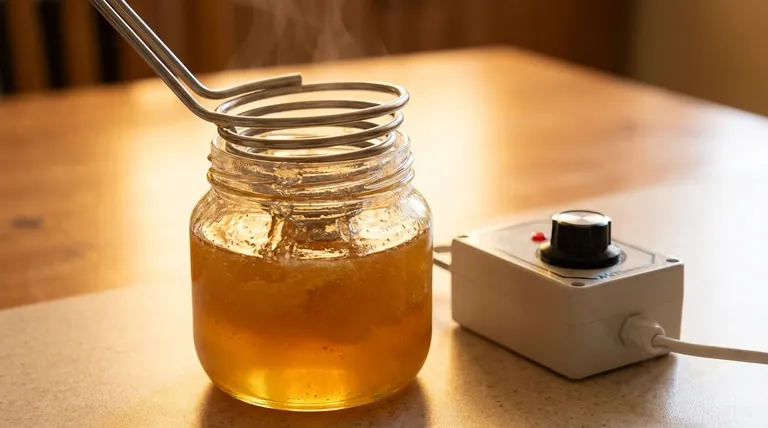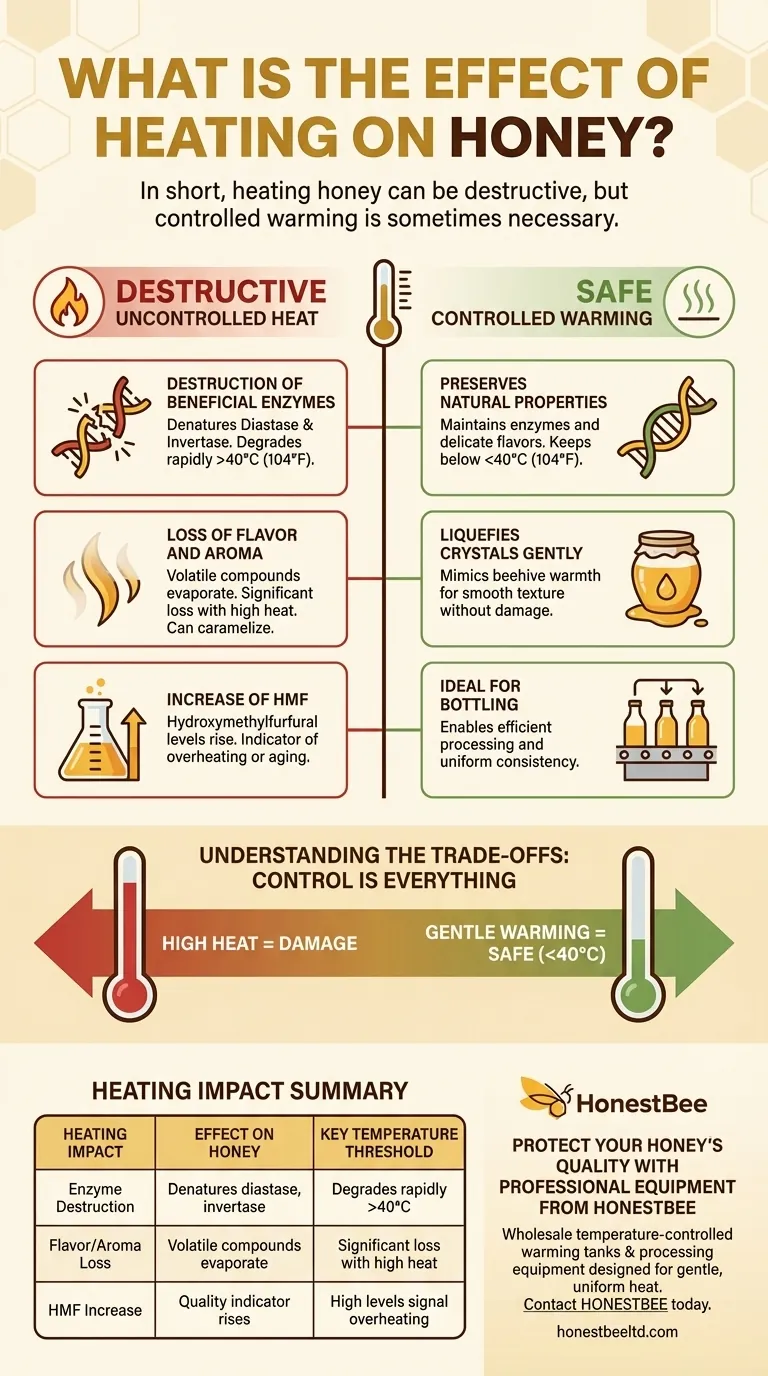In short, heating honey can be destructive. Applying excessive or uncontrolled heat degrades the quality of honey by destroying its beneficial enzymes, diminishing its unique flavor and aroma, and altering its chemical composition. While gentle warming has its place, high-temperature heating fundamentally damages the natural properties that make honey a valued product.
The central issue is not whether to heat honey, but how. Uncontrolled, high-temperature heating is always damaging, but gentle, controlled warming below 40°C (104°F) is a necessary and safe practice for managing honey's state without destroying its quality.

Why Heat is a Concern in Honey
To understand the effects of heating, we must first recognize why honey is heated. The two primary reasons are to reverse crystallization and to reduce moisture content, both of which present challenges for storage and use.
To Liquefy Crystallized Honey
Crystallization is a natural process where the glucose in honey separates from water and forms tiny crystals. This is a sign of pure, raw honey, not spoilage. However, crystallized honey is difficult to pour, so gentle heat is often used to re-liquefy it.
To Reduce Moisture Content
Honey with a moisture content above 18-20% is at risk of fermenting. Some beekeepers may harvest "unripe" honey with excess moisture and use processing techniques to reduce it for long-term stability. While heating is one method, it is not the preferred one.
The Negative Impacts of Uncontrolled Heat
When honey is heated too quickly or to too high a temperature, a cascade of negative effects occurs, permanently altering its character.
Destruction of Beneficial Enzymes
Honey contains enzymes like diastase and invertase, introduced by bees during production. These enzymes are markers of honey quality and are highly sensitive to heat. Exposing honey to high temperatures rapidly denatures and destroys them, diminishing its nutritional and functional value.
Loss of Flavor and Aroma
The delicate, complex flavors and aromas of honey come from volatile compounds. High heat causes these compounds to evaporate, leaving behind a more generic, sugary taste. In severe cases, it can caramelize the sugars, imparting a burnt or unpleasant flavor.
Increase of HMF
Heating honey also increases the levels of Hydroxymethylfurfural (HMF), a compound formed from the breakdown of fructose. While present in trace amounts naturally, high levels of HMF are a clear indicator that the honey has been overheated or is very old, and it is a key quality metric used in the international honey trade.
Understanding the Trade-offs: Control is Everything
The debate is not about heat versus no heat, but about destructive heat versus controlled warming. The blanket statement that all heat is bad is an oversimplification.
The Myth of "No Heat Ever"
For commercial packing and bottling, honey must be liquid. A professional "honey heating tank," as mentioned in the references, is designed to provide gentle and uniform heat. This maintains the honey's liquid state for processing without causing the damage associated with rapid or high-temperature methods.
The "Gentle Heat" Threshold
Most experts agree that keeping honey below 40°C (104°F) is the safest threshold for preserving its enzymes and delicate flavors. This temperature mimics the natural warmth inside a beehive and is sufficient to slowly liquefy crystals without causing significant degradation.
Home Methods vs. Professional Control
The greatest risk comes from uncontrolled home methods. Microwaving honey is especially damaging, as it creates intense hot spots that scorch the honey. Similarly, heating it directly on a stove can easily overheat and ruin it. A gentle water bath is a much safer home alternative.
How to Handle Honey Safely
Your approach to heating should be dictated by your end goal.
- If your primary focus is preserving raw honey's full benefits: Avoid heat whenever possible and use non-heat methods like blowing air with a fan to reduce moisture.
- If your primary focus is liquefying crystallized honey for use: Use a gentle water bath, keeping the water warm (not hot) to the touch, and allow the honey to liquefy slowly.
- If your primary focus is preparing honey for bottling: Invest in a temperature-controlled warmer or use a large water bath where you can precisely monitor and maintain a low temperature.
Understanding the role of controlled heat empowers you to preserve the integrity of your honey.
Summary Table:
| Heating Impact | Effect on Honey | Key Temperature Threshold |
|---|---|---|
| Enzyme Destruction | Denatures diastase, invertase | Degrades rapidly above 40°C (104°F) |
| Flavor/Aroma Loss | Volatile compounds evaporate | Significant loss with high heat |
| HMF Increase | Quality indicator rises | High levels signal overheating |
Protect Your Honey's Quality with Professional Equipment from HONESTBEE
As a wholesale supplier to commercial apiaries and distributors, we understand that maintaining honey integrity is crucial for your business. Our temperature-controlled honey warming tanks and processing equipment are designed to provide gentle, uniform heat—preventing enzyme destruction and preserving flavor while ensuring efficient bottling operations.
Contact HONESTBEE today to discuss wholesale solutions that protect your product quality and maximize your operational efficiency.
Visual Guide

Related Products
- Professional Thermostatic Conical Honey Melter
- 10L Stainless Steel Electric Honey Press Machine
- Honey Concentrating Vacuum Heating Thickening Machine Dehumidifier for Honey
- 8-Frame Electric Self-Reversing Honey Extractor Spinner for Commercial Honey Extraction Equipment
- 0.5T Capacity Honey Dehumidifier Dryer with Vacuum Heating and Thickening Filtering Machine
People Also Ask
- How to permanently decrystallize honey? Embrace Its Natural State for Maximum Quality
- What is melter honey used for? A Low-Cost Ingredient for Bakers and Brewers
- How does the Bee Blanket help maintain honey quality? Preserve Enzymes with Gentle Hive-Mimicking Heat
- At what temperature does honey flow? Preserve Quality with the Perfect 95°F Sweet Spot
- What equipment is commonly used for heating and processing honey? Essential Tools for Every Beekeeper



















